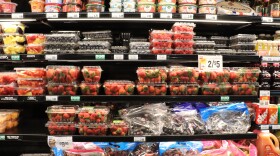-
Congress extends critical Farm Bill for a third time. It's a relief for farmers, but raises concernsThe federal funding package to reopen the government included a one-year extension of certain 2018 Farm Bill programs. Several expired Sept. 30 or would have been null by the end of the year.
-
The U.S. agricultural industry depends on undocumented immigrants, but President Trump's immigration crackdown is further depleting an already tight workforce. The labor crisis may be setting the stage for big changes to a federal program that allows foreign workers into the country legally.
-
Some Midwestern soybean farmers are selling their beans to be crushed and turned into soybean meal and oil. But economists say domestic processing won't be enough to offset the drop in Chinese demand.
-
Food bank staff expect a wave of new demand as millions of Americans are set to lose federal food assistance in November. But they insist that their services alone won't be enough to feed everyone who relies on the Supplemental Nutrition Assistance Program.
-
Bats love to munch on insects like stink bugs and moths. Some farmers are now relying on the mammals for pest control – and ditching chemicals.
-
Ranchers, lawmakers and farmers' unions are sounding the alarm over a Trump administration plan to increase beef imports from Argentina.
-
The government shutdown stops USDA from administering farm subsidies, raising the specter of growing farm foreclosures. It also delays a bailout President Trump had promised for farmers impacted by tariffs.
-
More than a million low-income mothers and children in the Midwest and Great Plains rely on a national food assistance program. The Trump administration says it will help provide temporary funding to keep the program afloat, but food advocates say it's a short-term fix.
-
The U.S. Department of Agriculture is expecting a strong corn and soybean harvest this year. But low crop prices, high input costs and international trade uncertainty could hurt farmers.
-
Several states, including Missouri, Illinois and Indiana, are in moderate to severe drought. Climatologists say it's unlikely to let up soon.

Play Live Radio
Next Up:
0:00
0:00
Available On Air Stations










